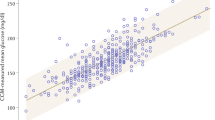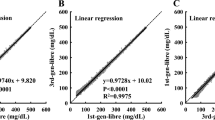Abstract
The development of a true reference measurement system by the International Federation for Clinical Chemistry (IFCC) for the first time allows reporting of true HbA1c results, standardized to an absolute value, worldwide. Regression equations between the IFCC assay and current harmonization assays, including the Diabetes Control and Complications Trial (DCCT) assay, are linear, tight, and stable over time. National and international setting of targets, audit and benchmarking of services will be easier than before, as will translation of research into clinical practice. Nevertheless, the main disadvantage of the IFCC assay is that the numbers and units reported (mmol/mol) are very different from the DCCT value (percentage). An extensive education program for patients and health-care professionals is, therefore, needed to prevent confusion and consequent deterioration in glycemic control. Furthermore, the IFCC system does not overcome difficulties inherent in the measurement and interpretation of HbA1c, such as in the presence of abnormal turnover of red blood cells and hemoglobinopathies.
This is a preview of subscription content, access via your institution
Access options
Subscribe to this journal
Receive 12 print issues and online access
$209.00 per year
only $17.42 per issue
Buy this article
- Purchase on Springer Link
- Instant access to full article PDF
Prices may be subject to local taxes which are calculated during checkout
Similar content being viewed by others
References
[No authors listed] The effect of intensive treatment of diabetes on the development and progression of long-term complications in insulin-dependent diabetes mellitus. The Diabetes Control and Complications Trial Research Group. N. Engl. J. Med. 329, 977–986 (1993).
[No authors listed] Intensive blood-glucose control with sulphonylureas or insulin compared with conventional treatment and risk of complications in patients with type 2 diabetes (UKPDS 33). UK Prospective Diabetes Study (UKPDS) Group. Lancet 352, 837–853 (1998).
Jeffcoate, S. L. Diabetes control and complications: the role of glycated haemoglobin, 25 years on. Diabet. Med. 21, 657–665 (2004).
Huisman, T. H. & Dozy, A. M. Studies on the heterogeneity of hemoglobin. V. Binding of hemoglobin with oxidized glutathione. J. Lab. Clin. Med. 60, 302–319 (1962).
Rahbar, S. Hemoglobin H disease in two Iranian families. Clin. Chim. Acta 20, 381–385 (1968).
Rahbar, S., Blumenfeld, O. & Ranney, H. M. Studies of an unusual hemoglobin in patients with diabetes mellitus. Biochem. Biophys. Res. Commun. 36, 838–843 (1969).
Bunn, H. F., Haney, D. N., Kamin, S., Gabbay, K. H. & Gallop, P. M. The biosynthesis of human hemoglobin A1c. Slow glycosylation of hemoglobin in vivo. J. Clin. Invest. 57, 1652–1659 (1976).
Little, R. R. et al. The national glycohemoglobin standardization program: a five-year progress report. Clin. Chem. 47, 1985–1992 (2001).
American Diabetes Association. Position statement: tests of glycemia in diabetes. Diabetes Care 21, S69–S71 (1998).
National Glycohemoglobin Standardization Program (NGSP) Harmonizing glycated hemoglobin testing [online], (2010).
Eckerbom, S., Bergqvist, Y. & Jeppsson, J. O. Improved method for analysis of glycated haemoglobin by ion exchange chromatography. Ann. Clin. Biochem. 31, 355–360 (1994).
Shima, K. et al. Interlaboratory differences in HbA1c measurement in Japan, an interim report of the committee on an interlaboratory standardization of HbA1c determination, the Japan Diabetes Society. J. Japan. Diab. Soc. 37, 233–243 (1994).
Shima, K. et al. Interlaboratory differences in GHb measurement in Japan, the fifth report of the GHb standardization committee, the Japan Diabetes Society. J. Japan. Diab. Soc. 41, 317–323 (1998).
Sacks, D. B. et al. Guidelines and recommendations for laboratory analysis in the diagnosis and management of diabetes mellitus. Clin. Chem. 48, 436–472 (2002).
Hoelzel, W. & Miedema, K. Development of a reference system for the international standardisation of HbA1c/glycohemoglobin determinations. J. Int. Fed. Clin. Chem. 9, 62–67 (1996).
Miedema, K. Towards worldwide standardisation of HbA1c determination. Diabetologia 47, 1143–1148 (2004).
Hanas, R. Psychological impact of changing the scale of reported HbA1c results affects metabolic control. Diabetes Care 25, 2110–2111 (2002).
International Federation of Clinical Chemistry and Laboratory Medicine. Recommendation for term and measurement unit for “HbA1c”. Clin. Chem. Lab. Med. 45, 1081–1082 (2007).
American Diabetes Association. Consensus statement on the worldwide standardisation of the HbA1c measurement. Diabetologia 50, 2042–2043 (2007).
International Expert Committee. International Expert Committee report on the role of the A1c assay in the diagnosis of diabetes. Diabetes Care 32, 1327–1334 (2009).
Heisler, M., Piette, J. D., Spencer, M., Kieffer, E. & Vijan, S. The relationship between knowledge of recent HbA1c values and diabetes care understanding and self-management. Diabetes Care 28, 816–822 (2005).
UK Department of Health NHS diabetes [online], (2010).
Diabetes UK. Guide to diabetes [online], (2010).
Goldstein, D. E. et al. Tests of glycemia in diabetes. Diabetes Care 27, 1761–1773 (2004).
O'Kane, M. J., Lynch, P. L., Moles, K. W. & Magee, S. E. Determination of a diabetes control and complications trial-aligned HbA(1c) reference range in pregnancy. Clin. Chim. Acta 311, 157–159 (2001).
Monnier, L., Colette, C. & Owens, D. R. Glycemic variability: the third component of the dysglycemia in diabetes. Is it important? How to measure it? J. Diabetes Sci. Technol. 2, 1094–1100 (2008).
Author information
Authors and Affiliations
Ethics declarations
Competing interests
Sally M. Marshall is a consultant for Diabetes UK and the UK Department of Health.
Rights and permissions
About this article
Cite this article
Marshall, S. Standardization of HbA1c: good or bad?. Nat Rev Endocrinol 6, 408–411 (2010). https://doi.org/10.1038/nrendo.2010.66
Published:
Issue Date:
DOI: https://doi.org/10.1038/nrendo.2010.66



